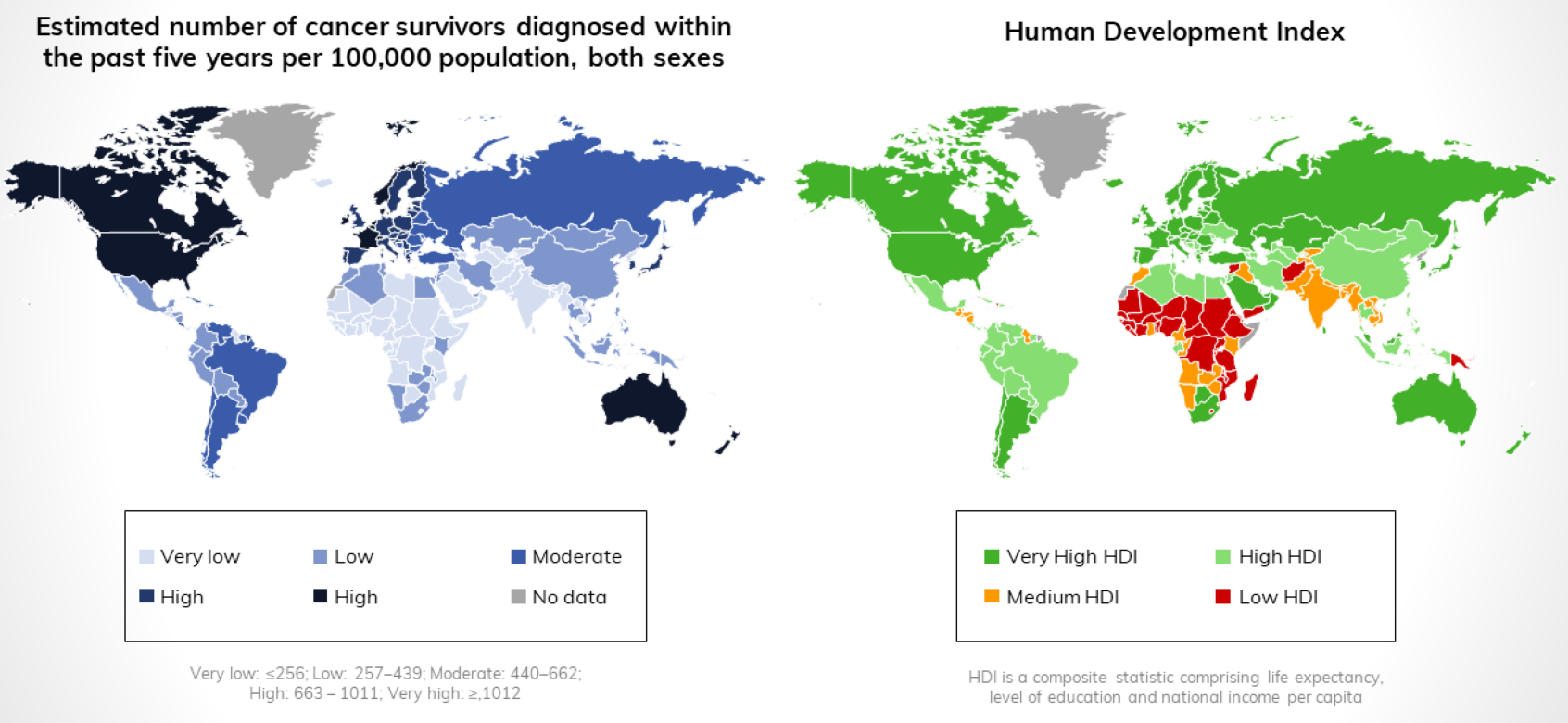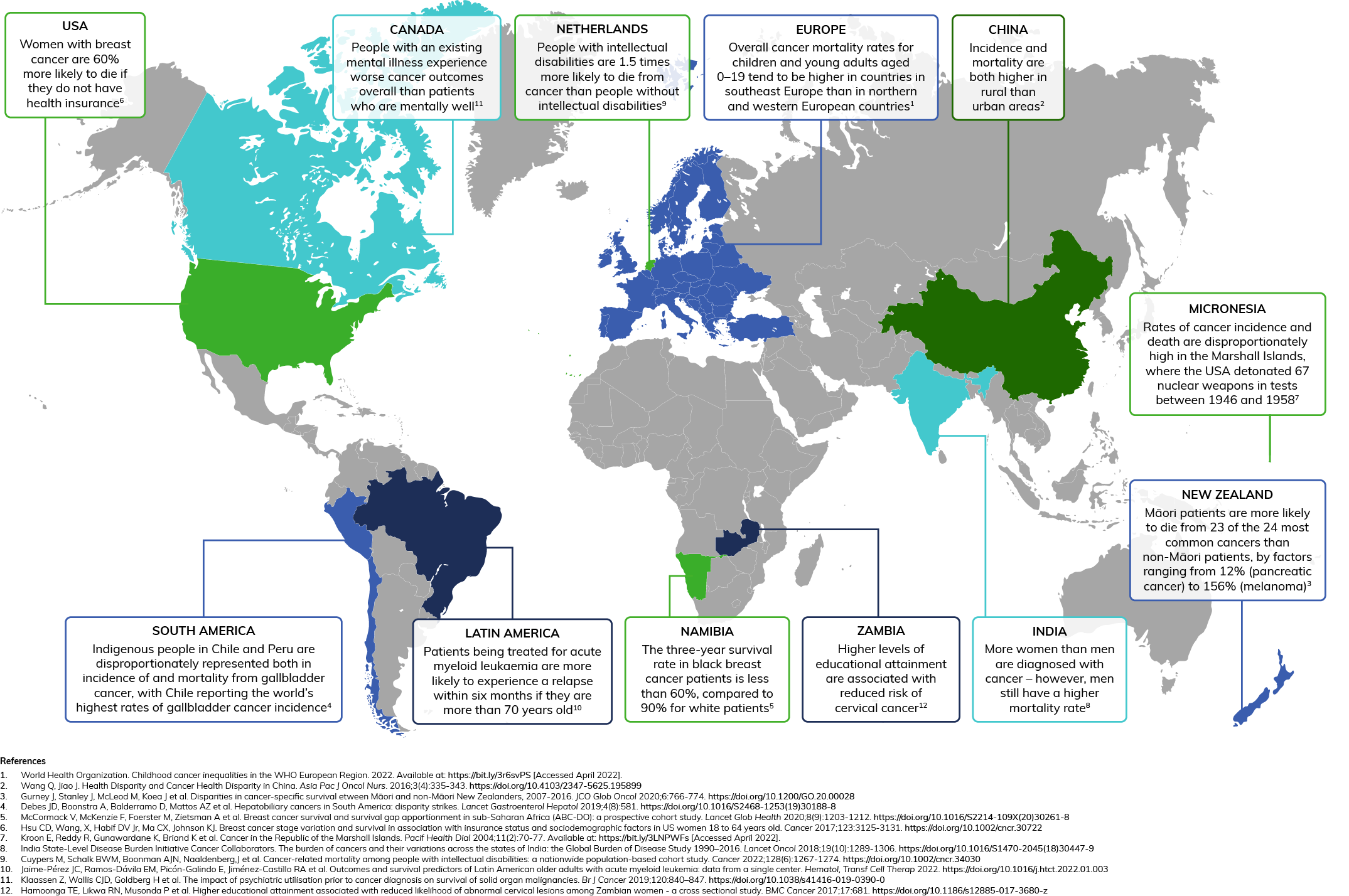Insights / Articles
Cancer Inequity: What is it and what can be done?
Written on Wednesday, September 7, 2022
What is the care gap?
There are glaring differences that exist in cancer outcomes and access to care across regions and socioeconomic groups. These inequities amount to a gap in cancer care. This year, the World Cancer Day theme is Close The Care Gap, a three-year campaign to combat inequity in cancer treatment, cancer diagnosis and access to care.
In this article, we illustrate the magnitude of this care gap by taking a look at its manifestations and causes, and then we consider how it can be alleviated.

Inequality of outcomes
The image above demonstrates the fundamental divide between high- and low-income countries in terms of cancer survival rates.1 Even within individual countries, the so-called deprivation gap2 means that patients from more deprived areas have worse cancer outcomes than those from wealthier areas. Indeed, low socioeconomic status in childhood is associated with a heightened risk of cancer in adulthood,3 and low socioeconomic status is linked with lowered survival rates in cancer patients.4
Poverty and location are both significant factors in cancer incidence and outcomes, but they are by no means the only contributors to the care gap. Minority ethnic patients commonly experience poorer cancer outcomes than white patients.5 Rates of cancer incidence and mortality both increase with age6 – advanced age is itself a risk factor for cancer7 – and older patients are more likely to present with complicating comorbidities.6 Worldwide, the incidence and mortality of cancer are both higher in men than women,8 and cancer outcomes are poorer among patients with physical9 and intellectual disabilities.10
The cancer care gap across the world
Inequities in cancer care are felt throughout the world in a multitude of diverse and intersecting ways. To illustrate the range and scope of the care gap, we have captured a selection of country- and region-specific examples in the below graphic.

What can be done?
Funding and infrastructure
It has been widely established that economic inequality is a significant determinant of cancer outcomes, both directly and as a result of factors tied to poverty, such as education, housing and difficulty accessing medical care.11 Funding is therefore a key issue in addressing the care gap, both in terms of targeted financial support for issues affecting access to care, such as transport, financial aid and child care, and increased research funding for underserved patient groups. However, there is evidence that the effects of increasing the funds available to disadvantaged patients are greatly heightened when implemented within a robust and accessible healthcare infrastructure, where measures are in place to help patients access care and staff receive regular, up-to-date training on patient engagement and health equity.12
Holistic service plans are not just beneficial in high-income countries. While funding is certainly a significant factor in addressing the inequities present in low- and middle-income countries, collaboration between services and in-country ownership of health strategies are equally crucial for shoring up long-term cancer care infrastructure.13
Policy and education
Targeted, patient-led task forces and working groups can drive efforts to enshrine equity within health policy.14The European Commission has established a European Cancer Inequalities Registry, aimed at identifying and addressing inequities throughout the EU, as part of its ongoing Beating Cancer Plan.15
Representation of marginalized groups across the care and treatment space is similarly important, and improving race and sex diversity in oncology teams can help to address both discrimination at the treatment level and disparities in research.16 Members of some underserved communities can be reluctant to access cancer diagnosis and treatment even where they are available, often out of a combination of fear and mistrust: here, community-based programs with a strong focus on patient outreach and education have shown significant positive results.17
Innovation and development
Technological innovation has the potential to alleviate social inequality in cancer care,18 if it is appropriately and affordably implemented: NHS England’s Innovative Medicines Fund, for example, grants patients early access to the most promising emerging treatments while real-world evidence is being collected.19
The growing complexity of emerging cancer treatments may make them more expensive, thereby further widening the disparity between low- and high-income patients.20 However, the development of biosimilar medicines can drive competition between producers, leading to lowered prices and wider ranges of choice for patients and healthcare providers.21 In these cases, the cost savings from biosimilars and other affordable value-based medicines can then be reinvested in further improving treatment.22
Conclusion
We know the cancer care gap can be exacerbated by a range of factors pertaining to money, from economic issues affecting individual patients to the differences in care available in higher- versus lower-income countries. Widespread increases in funding for cancer research, treatment and healthcare infrastructure would doubtless significantly aid in alleviating inequity in cancer care and access to treatment. For funding to achieve its full effect, it should be complemented by a focus on innovation in accessible treatment, as well as initiatives and programs that have been shown to improve equitable treatment of patients.
References
- World Health Organization. World Cancer Day: closing the care gap. 2022. Available at: https://bit.ly/3uWsPSu [Accessed April 2022].
- Nuñez O, Rodríguez Barranco M, Fernández-Navarro P et al. Deprivation gap in colorectal cancer survival attributable to stage at diagnosis: a population-based study in Spain. Cancer Epidemiol. 2020;68:101794. https://doi.org/10.1016/j.canep.2020.101794
- Vohra J, Marmot MG, Bauld L et al. Socioeconomic position in childhood and cancer in adulthood: a rapid-review. J Epidemiol Community Health 2016;70:629-634.
- Redondo-Sánchez D, Petrova D, Rodríguez-Barranco M, Fernández-Navarro P et al. Socio-economic inequalities in lung cancer outcomes: an overview of systematic reviews. Cancers. 2022;14(2):398. https://doi.org/10.3390/cancers14020398
- Zavala VA, Bracci PM, Carethers JM et al. Cancer health disparities in racial/ethnic minorities in the United States. Br J Cancer2021;124:315–332. https://doi.org/10.1038/s41416-020-01038-6
- Walsh PM, McDevitt J, Deady S, O’Brien K, Comber H. Cancer inequalities in Ireland by deprivation, urban/rural status, and age: a report by the National Cancer Registry. 2016. Available at: https://bit.ly/378lozA [Accessed April 2022].
- Schroyen S, Adam S, Jerusalem G, Missotten P. Ageism, and its clinical impact in oncogeriatry: state of knowledge and therapeutic leads. Clin Interv Aging 2015;10:117-125. https://doi.org/10.2147/CIA.S70942
- Global Burden of Disease Cancer Collaboration. Global, regional, and national cancer incidence, mortality, years of life lost, years lived with disability, and disability-adjusted life-years for 29 cancer groups, 1990 to 2017: a systematic analysis for the Global Burden of Disease Study. JAMA Oncol 2019;5(12):1749–1768. https://doi.org/10.1001/jamaoncol.2019.2996
- Choi JY, Yeob KE, Hong SH et al. Disparities in the diagnosis, treatment, and survival rate of cervical cancer among women with and without disabilities. Cancer Control 2021;28. https://doi.org/10.1177/10732748211055268
- Liu Q, Adami HO, Reichenberg A, Kolevzon A, Fang F et al. Cancer risk in individuals with intellectual disability in Sweden: A population-based cohort study. PLOS Med 2021;18(10):e1003840. https://doi.org/10.1371/journal.pmed.1003840
- Cancer Research UK. Cancer in the UK 2020: socio-economic deprivation. 2020. Available at: https://bit.ly/3B5CPxq [Accessed July 2022].
- Racial disparities in cancer care: can we close the gap? Lancet Oncol 2021;22:1643. https://doi.org/10.1016/S1470-2045(21)00669-0
- Morgan GW, Foster K, Healy B, Opie C, Huynh V. Improving health and cancer services in low-resource countries to attain the Sustainable Development Goals target 3.4 for noncommunicable diseases. J Global Oncol 2018;4:1-11. https://doi.org/10.1200/JGO.18.00185
- European Cancer Organisation. Inequalities Network. 2022. Available at: https://bit.ly/3ohUsTh [Accessed July 2022].
- European Commission. European Cancer Inequalities Registry: policy context. 2021. Available at: https://bit.ly/3omj7WM [Accessed July 2022].
- Patel MI, Lopez AM, Blackstock W, Reeder-Hayes K, Moushey EA, Phillips J, Tap W. Cancer disparities and health equity: a policy statement from the American Society of Clinical Oncology. J Clinical Oncol 2020;38(29):3439-3448. https://doi.org/10.1200/JCO.20.00642
- Sprague Martinez L, Freeman ER, Winkfield KM. Perceptions of cancer care and clinical trials in the black community: implications for care coordination between oncology and primary care teams. Oncologist 2017;22(9):1094-1101. https://doi.org/10.1634/theoncologist.2017-0122
- Sullivan R, Aggarwal A. Technology, and cancer systems: creating better policy to enhance equality. In: Vaccarella S, Lortet-Tieulent J, Saracci R et al (eds). Reducing social inequalities in cancer: evidence and priorities for research. 2019. Available at: https://bit.ly/3onq6OZ [Accessed July 2022].
- Department of Health and Social Care, Javid S. Patients to have earlier access to cutting-edge treatments on NHS. 2022. Available at: https://bit.ly/3onRg8A [Accessed July 2022].
- Simoens S, Harten W, Lopes G, Vulto A, Meier K, Wilking N. What happens when the cost of cancer care becomes unsustainable? Touch Oncol & Haematol 2017;217:epub. https://doi.org/10.17925/EOH.2017.13.02.108
- Peeters M, Planchard D, Pegram M, Gonçalves J, Bocquet F, Jang H. Biosimilars in an era of rising oncology treatment options. Future Oncol 2021;17(29):3881-3892. https://doi.org/10.2217/fon-2021-0546
- Lopes G, Vulto A, Wilking N, Harten W, Meier K, Simoens S. Potential solutions for sustaining the costs of cancer drugs. European Oncol & Haematol 2017;13:102. https://doi.org/10.17925/EOH.2017.13.02.102
CAN WE HELP?
For information about OPEN Health’s services and how we could support you, please get in touch.
JOIN US
Visit our careers page to view opportunities at OPEN Health.